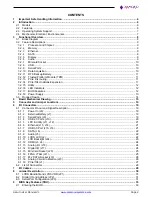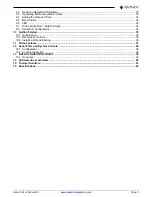
Saturn User Manual V1
Page 10
3.2.7
Minicard Socket
The board provides expansion for one full size (51mm length) Minicard socket. The socket supports mPCIe add on
cards. Minicard interface support PCIex1 lane port and one USB2.0 port. Access to sim card signals are not
provided. If LTE modem need to be used, please select module with SIM connector.
SBC provides 2nos onboard M2 3.55mm spacer and M2 screws to mount minicard module
3.2.8
USB
The board offers seven USB 2.0 ports and two USB 3.0 ports directly from the processor.
One USB 2.0 port is connected to the Mini card socket, two are made available on dual row 2x5 2mm pitch latching
connector, and another two are available on one bank PCIe/104 connector.
USB 3.0 ports are available on 2nos of dual row, 2x5 2mm pitch latching connectors along with USB2.0 ports.The
USB3.0 and USB2.0 port mappings are as below:
USB3.0 Ports
Port Number
Port Termination
Port 0
USB3.0 Connector1
Port 1
USB3.0 Connector2
USB2.0 Ports
Port Number
Port Termination
Port 0
USB3.0 Connector1
Port 1
USB3.0 Connector2
Port 2
Mini Card Connector
Port 3
PCIe/104 Connector
Port 4
Port 5
USB2.0 Connector
Port 6
3.2.9
Serial Ports
The board provides 3 serial ports from the processor. Two serial ports support RS-232/422/485 protocols using
Exar SP336 multiprotocol transceivers. Protocol selection are controlled by FPGA gpio and configurable via
application software. TX / RX 121-ohm line termination resistors for RS-422/485 can controlled by Jumper.
One serial port supports RS232 protocol using the RS232 transceiver. In RS-232 mode, only signals TX, RX are
provided. Option for TTL level signals is provided. The RS232 port is also used as console redirection for
debug/development purposes.
The serial ports are terminated on dual row, 2x5 2mm pitch latching connectors. One such connector provides
access to two serial ports.RS232 port is made available as part of the utility connector.
3.2.10 Data Acquisition
The board provides an optional data acquisition subcircuit containing analog input, analog output, and digital I/O
features. This circuit is controlled by an FPGA attached to the processor via the LPC bus. A pin header on the board
provides access to JTAG signals for reprogramming the FPGA on the board and in the field.
Features of the DAQ subcircuit include: 16 single-ended / 8 differential analog inputs with 16-bit resolution,
programmable input ranges, and 250KSPS maximum throughput; 4 analog outputs with 16-bit resolution and
programmable output ranges; and 22 digital I/O lines with selectable 3.3V/5V logic levels, selectable pull-up/down
resistors, programmable direction, buffered I/O, and capability for use as counter/timer and PWM circuits.











































